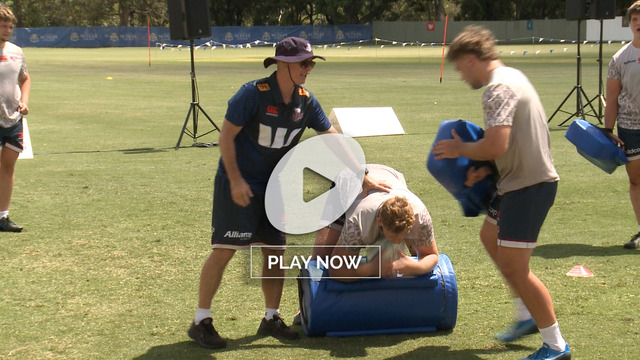Why the counter-ruck is gaining currency on defence
Six months ago, I wrote the following article, asking whether the new ruck directives, designed to produce quicker outcomes at the breakdown, would encourage the return of the counter-ruck. The answer has been clearly in the affirmative.
The key tackle law is 14.7.a:
“Tackled players must immediately make the ball available so that play can continue by releasing, passing or pushing the ball in any direction except forward.”
Under the new guidelines, the opportunity for tackled players to make extra movements – ‘rolls’ or ‘crawls’ or ‘rabbits’ – along the ground was removed once they had been brought to ground. Flip the coin over, and defenders were required to clear the tackle area faster, and without impeding the cleanout or the attacking 9 as they approached the tackle zone. Defenders competing for the ball on the deck had to support their bodyweight at all times, and were only allowed one crack at lifting the ball.
As I concluded in the earlier article:
“If these articles of rugby law are respected, alongside the requirement to maintain a body position with shoulders no lower than hips, there is every possibility of a new picture of the ruck emerging."
“Once the tackled player releases the ball immediately by placing it away from his body, and players from both sides look to enter with their shoulders on a plane level with their hips, the situation at the post-tackle is more likely to be resolved by cleanout (for the attacking side) and counter-ruck (for the defence).”
In the recently-concluded Rugby Championship, the counter-ruck responded positively to the jolt given by the law-making defibrillator, and made something of a comeback from the dead!
Let’s take a look at some examples of situations in which a counter-ruck can become the preferred weapon of choice for the defence at the breakdown, instead of trying to pilfer the ball by hand.
The tournament finished with the best game of the tournament, the return match between New Zealand and South Africa. The Springboks have the largest number of weapons of any side on the global stage when they opt to contest the defensive breakdown. They finished with four of the top 10 ‘jackals’ in the tournament, and 14 of their 15 starters have won turnover at the post-tackle in the course of the current season.
They also use the counter-ruck as a major platform for attack at the post-tackle. This prolonged sample comes from the second game:
What are the KPI’s for the success of a counter-ruck? In the first instance, there has to be some forward momentum on to the tackle ball from the initial defender. They have to be able to at least establish themselves in the space above the ball-carrier, with lower leverage than their immediate opponent:

Here the South African centre Damian de Allende has established himself directly over the top of the man placing the ball (second row Brodie Retallick), and he is in a lower, more dynamic position than his opponent (Kiwi number 8 Luke Jacobson). That is the trigger for the second man (Springbok captain Siya Kolisi) to enter as the ‘engine’ behind de Allende, and drive him across the centre-line of the ruck.
The Springboks counter-rucked not once, but twice to win possession of the ball in one long, winding 18 second sequence:
In the second example, the roles are reversed, with Kolisi leading the counter-drive after gaining underneath leverage on New Zealand number 10 Beauden Barrett, and de Allende firing him across the midpoint of the new ruck. Finally, Retallick is forced to concede possession by booting the ball through on to the South African side.
The same two defenders had been involved in a successful counter-ruck near the Springbok line in the first game:
There is an initial defensive shunt which propels New Zealand number 12 David Havili back in the tackle, and that gives de Allende leverage against the first cleanout support (Kiwi number 13 Rieko Ioane):

The ball has to be released more quickly under the new directives, and that allows the second man (Kolisi) to fire in and complete the turnover.
The Springboks did not however, enjoy a monopoly on counter-ruck turnovers in the competition, and they were hoist by their own petard in the double-header versus the Wallabies:
In this case the errant pass from full-back Willie le Roux plays the role of ‘offensive tackle’ by sending the receiver (Franco Mostert) back in the direction of his own try-line. Australian number 8 Rob Valetini establishes himself above the ball, and Michael Hooper and Len Ikitau add themselves without hesitation to fire him across the midpoint of the ruck.
The ruck is particularly instructive, because Mostert hangs on to the ball and attempts to make a double move on the ground in order to maintain possession. Under the old breakdown laws, he might have got away with it too, but the new demand for immediate release rewards the counter-ruck – and rightly so.
Later in the first period with the Boks hot on attack, Wallaby wing Marika Koroibete made another crucial decision to instigate a counter-ruck:
Koroibete’s initial impact is such that it forces both South African cleanout players to yield a step backwards, and that is all the encouragement that Hooper and Co. need to fire him straight across the midpoint of the tackle:

Australia completed the turnover, but the ball-carrier (Springbok wing Makazole Mapimpi) could easily have been penalized for playing the ball twice on the ground.
Summary
During the Rugby Championship, there were encouraging signs that more of the game at the post-tackle was being played on balance and on the feet, rather than off them. With the demand for immediate release on both sides, there is now far more opportunity for constructive counter-rucking by the defence. Body-shapes are more positive with shoulders either above, or in the same plane as the hips.
The counter-ruck is alive and well – long live the counter-ruck!













.jpg)
.jpg)





_no_button.jpg)

